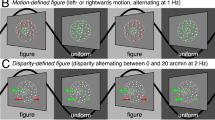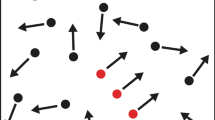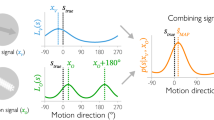Abstract
THE visual system has no difficulty maintaining the identity of an object as it disappears and reappears behind stationary occluders. In the natural world, a moving object may differ from occluders by many characteristics (colour, depth, shape and so on). Scene segmentation based on these characteristics is thought to happen early in visual processing, and to influence how objects, including moving objects, are identified1–5. What happens if the only characteristic distinguishing an object is its direction of motion? Experiments with random dot displays show that one dot moving in a constant trajectory is readily detected among identical dots in brownian motion6. Detection declines sharply if the trajectory is intermittently broken, but improves if occluders obscure the breaks in the trajectory. It is not sufficient that these occluders be perceived as segmented from the rest of the display (such as by colour or depth). Rather, it is critical that the occluders do not contain motion that is similar in direction to that of the target trajectory. We conclude that detection of the trajectory is due to the integration of information within a network of low-level motion detectors and is not dependent on segmentation processes7.
This is a preview of subscription content, access via your institution
Access options
Subscribe to this journal
Receive 51 print issues and online access
$199.00 per year
only $3.90 per issue
Buy this article
- Purchase on Springer Link
- Instant access to full article PDF
Prices may be subject to local taxes which are calculated during checkout
Similar content being viewed by others
References
Nakayama, K. & Shimojo, S. Vision Res. 30, 1811–1825 (1990).
Shimojo, S., Silverman, G. H. & Nakayama, K. Nature 333, 265–268 (1988).
He, Z. L. & Nakayama, K. Nature 367, 173–175 (1994).
He, Z. L. & Nakayama, K. Nature 359, 231–233 (1992).
Braddick, O. J. Nature 333, 803–804 (1988).
Watamaniuk, S. N. J., McKee, S. P. & Grzywacz, N. M. Vision Res. 35, 65–77 (1995).
Yuille, A. L. & Grzywacz, N. M. Nature 333, 71–74 (1988).
Grzywacz, N. M., Smith, J. A. & Yuille, A. L. in The Proceedings of the IEEE Workshop on Visual Motion 148–155 (IEEE Computer Society, 1989).
Grzywacz, N. M., Watamaniuk, S. N. J. & McKee, S. P. Vision Res. 325 (in the press).
Shipley, T. F. & Kellman, P. J. Spatial Vis. 7, 323–339 (1993).
Bowne, S. F., McKee, S. P. & Glaser, D. A. J. opt. Soc. Am. A 6, 1112–1121 (1989).
Author information
Authors and Affiliations
Rights and permissions
About this article
Cite this article
Watamaniuk, S., McKee, S. Seeing motion behind occluders. Nature 377, 729–730 (1995). https://doi.org/10.1038/377729a0
Received:
Accepted:
Issue Date:
DOI: https://doi.org/10.1038/377729a0
This article is cited by
-
A Cortical-Inspired Geometry for Contour Perception and Motion Integration
Journal of Mathematical Imaging and Vision (2014)
-
A model of attention and memory based on the principle of the dominant and the comparator function of the hippocampus
Neuroscience and Behavioral Physiology (2005)
-
A model of attention and memory based on the principle of the dominant and the comparator function of the hippocampus
Neuroscience and Behavioral Physiology (2005)
-
Perceived visual speed constrained by image segmentation
Nature (1996)
Comments
By submitting a comment you agree to abide by our Terms and Community Guidelines. If you find something abusive or that does not comply with our terms or guidelines please flag it as inappropriate.



